Old Book - New Life, Or, "You Don't Look a Day Over 300…"
(click to enlarge)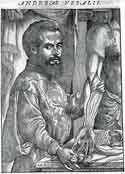 |
| Vesalius portrait, by Jan Stephan. |
(click to enlarge)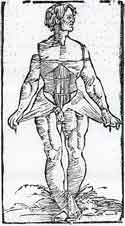 |
| Pre-Vesalius medical illustration of “long muscles” from Isagogae Breves et Exactissimae…by Jacopo Berengario da Carpi, 1530. |
 homas Jefferson University’s Archives and Special Collections at Scott Memorial Library holds almost 5,000 rare books. Chief among those prized works is an original, 1543 first edition of De Humani Corporis Fabrica by Andreas Vesalius (1514-1564). It was donated by Robert Lewis Phillips, M.D., (JMC 1952) at his 25th Class Reunion in 1977. He also gifted another (even rarer) important first edition, Cinq Livres de Chirugie (1572) by Ambroise Paré.
homas Jefferson University’s Archives and Special Collections at Scott Memorial Library holds almost 5,000 rare books. Chief among those prized works is an original, 1543 first edition of De Humani Corporis Fabrica by Andreas Vesalius (1514-1564). It was donated by Robert Lewis Phillips, M.D., (JMC 1952) at his 25th Class Reunion in 1977. He also gifted another (even rarer) important first edition, Cinq Livres de Chirugie (1572) by Ambroise Paré.
According to The Oxford Medical Companion, "probably the most influential of all medical works" and proclaimed by Sir William Osler as “the greatest medical work ever printed…from which modern medicine starts,” de Fabrica is notable because of the great art which is displayed in the 200+ anatomical renderings.
(click to enlarge)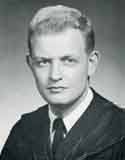 |
| Dr. Robert Lewis Phillips, JMC Class of 1952, at graduation. |
(click to enlarge)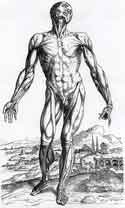 |
| “Muscle man” from De Humani Corporis Fabrica, 1543. |
Although Vesalius was famous for correcting many errors, long-repeated from the ancient Galenic authorities, and refocusing human anatomy by dissecting humans (rather than dogs and other mammals), the importance of de Fabrica is found in the serious and accurate illustrations. The relative significance of the text may be put in perspective in that it was translated from the Latin only in the 20th century, although for over 400 years the iconic images appeared in countless direct and pirated versions.
Vesalius worked closely with the artist of de Fabrica, Jan Stephan, who was his fellow countryman (from Flanders, modern Belgium) and a student of the Venetian master, Titian. Although not printed or recorded in the work, his style, along with information by Renaissance biographer Vasari, identified Stephan as the artist.
The University Archives not only provides intellectual management of the rare book collections (identifying, cataloging, making accessible), but also cares for the physical requirements including security and maintenance. In the summer of 2004, financed through a special fund, the Conservation Center for Art and Historic Artifacts (CCAHA) in Philadelphia repaired the minor but significant accidents and wear to this well-used book on its 461st birthday.
De Fabrica measures 16 3/8” h x 11 1/2” w x 2 3/8” d (folio size) and consists of 659 pages weighing-in at 10 lbs. It is bound in burgundy-dyed goatskin, tooled, dating from the early 20th century. The textblock had been trimmed and gilded on the fore edge. Composed of handmade laid paper, it had been cleaned (and bleached?) and pressed to make a crisp, tight presentation.
Over the years the covers had come loose and were in danger of breaking off. Some leaves had been torn and some “repaired” tears had adhesive marks which had darkened (possible animal glue or gelatin). The conservator restored and strengthened the binding, and repaired the torn leaves, removing the discolored adhesive material and cleaned and treated both the covers and soiled leaves. A new custom-made cloth-covered clamshell box was created to provide additional support and protection from damaging environmental factors (light, temperature, relative humidity fluctuation, pollutants).
University Archives at Scott Memorial Library also holds the enlarged 1555 edition of de Fabrica, as well as a copy of the German 1783 pressing. In 1934, the New York Academy of Medicine and the University of Munich collaborated on producing a fine press edition of Vesalius’ and Jan Stephan’s works utilizing the original woodcut blocks which scholars had discovered at the latter institution’s library. Much was learned about late-medieval/Renaissance woodcarving and printing methods from this limited run (615). Sadly this was the final printing from the original woodcuts as all 227 remaining artifacts were destroyed during Allied bombing of Munich in 1945.
You may schedule a visit to our Archives to view the rare first and final editions side by side.
(click to enlarge)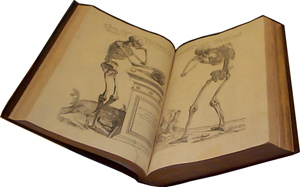 |
| Restored De Humani Corporis Fabrica, 1543. |
Related Links:
- Conservation Center for Art and Historic Artifacts
- Andreas Vesalius' De Fabrica…eBook versions.
- Ambroise Paré’s, Cinq Livres…eBook version.